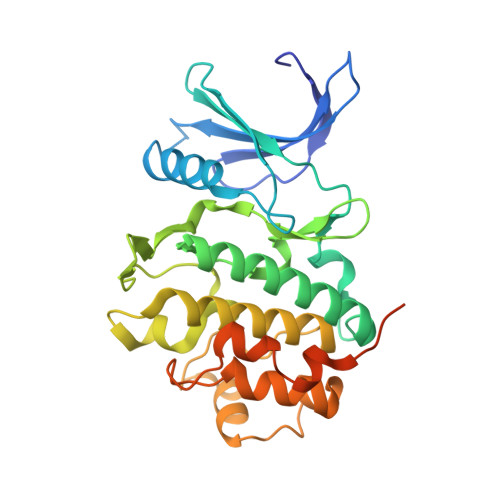Identification of Chemically Diverse Chk1 Inhibitors by Receptor-Based Virtual Screening.
Foloppe, N., Fisher, L.M., Howes, R., Potter, A., Robertson, A.G.S., Surgenor, A.E.(2006) Bioorg Med Chem 14: 4792
- PubMed: 16574416
- DOI: https://doi.org/10.1016/j.bmc.2006.03.021
- Primary Citation of Related Structures:
2CGU, 2CGV, 2CGW, 2CGX - PubMed Abstract:
Inhibition of the Chk1 kinase by small molecules is of great therapeutic interest for oncology and in understanding the cellular regulation of the G2/M checkpoint. We report how computational docking of a large electronic catalogue of compounds to an X-ray structure of the Chk1 ATP-binding site allowed prioritisation of a small subset of these compounds for assay. This led to the discovery of 10 novel Chk1 inhibitors, distributed among nine new and clearly different chemical scaffolds. Several of these scaffolds have promising lead-like properties. All these ligands act by competitive binding to the targeted ATP site. The crystal structures of four of these compounds bound to this site are presented, and reasonable modelled docking modes are suggested for the 5 other scaffolds. This structural context is used to assess the potential of these scaffolds for further medicinal chemistry efforts, suggesting that several of them could be elaborated to make additional interactions with the buried part of the ATP site. Some unusual interactions with the conserved kinase backbone motif are pointed out. The ligand-binding modes are also used to discuss their medicinal chemistry potential with respect to undesirable chemical functionalities, whether these functionalities bind directly to the protein or not. Overall, this work illustrates how virtual screening can identify a diverse set of ligands which bind to the targeted site. The structural models for these ligands in the Chk1 ATP-binding site will facilitate further medicinal chemistry efforts targeting this kinase.
- Vernalis (R&D) Ltd, Granta Park, Abington, Cambridge CB1 6GB, UK. n.foloppe@vernalis.com
Organizational Affiliation:

















